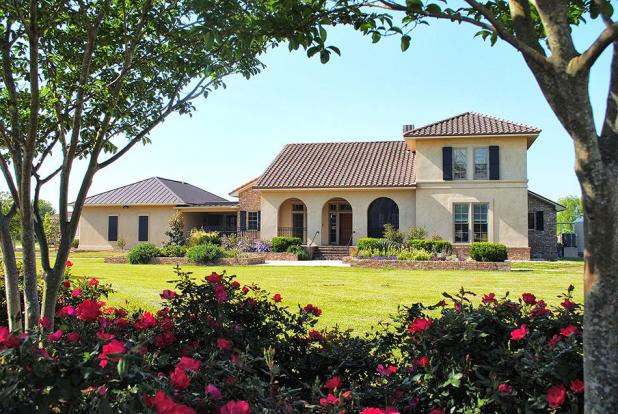
LSU AgCenter LaHouse
Make your home more wind resilient
BATON ROUGE — The images of damaged homes from the recent rash of storms and tornadoes are tragic reminders of the increasing importance of making your home resilient to future windstorms, according to LSU AgCenter professor emerita Claudette Hanks Reichel.
“It is possible and practical for a home to resist serious damage from windy storms, hurricanes and, yes, even tornadoes,” said Reichel, of the AgCenter LaHouse Home and Landscape Resource Center.
Although a direct hit from a strong tornado is invariably destructive, it is uncommon. However, homes along the outer edges of tornadoes and even those in the direct path of weak tornadoes can be fortified to withstand those wind levels as well as most hurricanes.
Take control of your future by making your home more resilient before the next storm with these wind-hardy improvements. Today, many wind-resistant products are widely available. It’s a great investment to upgrade to wind-rated products and systems when replacing damaged materials, even if your insurance won’t cover the incremental cost.
Roof: When reroofing, remove all of the existing roof covering and specify a wind-tested and rated roofing system. It must be installed according to the manufacturer’s high-wind instructions to perform as rated and be covered by the wind warranty.
For more detailed information to share with your roofing contractor, get the fortified roof checklist at www.disastersafety.org. You can also learn more by viewing LaHouse’s “Get a Storm Ready Roof” video at www.youtube.com/myLaHouse.
1. Make sure you have a minimum roof decking thickness of 7/16 inch, but if replacing the entire deck, consider upgrading to 5/8-inch plywood for a stronger and more resilient roof.
2. Reinforce both existing and new roof decking with 8d ring shank nails (at least 0.113 inches in diameter and 23/8 inches long with a full round head) spaced every 6 inches. On gable ends, the nails should be placed every 4 inches. Do not fasten roof decking with staples or screws.
3. Add a secondary moisture barrier to prevent leaks at decking seams if roofing is lost to high wind. This can be created by taping the decking seams with a roof flashing tape. Do not use window flashing tape.
4. Use wide adhesive membrane flashing in roof valleys and along eaves and gables. Properly install new flashing at all penetrations and roof and wall intersections. Install new drip edge over the underlayment and fasten every 4 inches.
5. Upgrade the underlayment. Use at least No. 30 roofing felt. Even better options are a tear-resistant No. 30 synthetic underlayment or an adhesive membrane (peel and stick) underlayment for greatest protection (no need for taped seams if this is used).
6. Select a wind-tested roof system rated above the local code wind speed. Wind- and hail-resistant asphalt shingle, metal, slate and tile systems are now readily available — but you must specify them. For shingles, use at least Class F (ASTM D3161), or choose Class H (ASTM D7158 rated for 150 mph) for highest wind resistance.
High wind-rated shingles usually require matched starter strips and six nails per tab to perform as tested and be wind warranted. Note that shingle life warranties (number of years) are not an indicator of wind resistance, so a high-cost, 40-year architectural shingle that is not wind-rated might not perform well in high wind.
7. Use only TAS 100(A) tested ridge or roof vents. Securely fasten strong soffit panels and vents under roof overhangs to the framing. Perforated fiber cement soffits are a sturdy, one-step, low- maintenance option.
Structure: If walls are open or siding is removed, add metal hurricane hardware to strengthen connections of wall framing to the foundation, to the roof rafters or trusses and between levels to resist uplift forces. Consider adding corner hold-downs and reinforcements of narrow wall sections to resist racking forces.
Even if you can’t add wall connectors at this time, you may be able to reinforce your roof system from inside the attic. Add hurricane clips to connect each rafter to the wall framing. Consider applying construction adhesive along each side of rafter or roof decking joints to reinforce the roof decking.
Also strengthen accessory structures (screen porches, tool sheds, etc.) that could become flying debris. Remove trees and limbs near the house that pose a risk of breaking or uprooting.
Windows, doors and garage doors: High winds and flying debris can break windows and push in or pull out a standard garage door or entry door, allowing pressure to build inside and push on the roof and surrounding walls. This can cause major structural damage to a home. If in a high-wind zone and replacing any windows, doors or garage doors, invest in wind- and impact-rated units. If not replacing them, consider adding easy-to-use windborne debris protections such as impact-rated shutters, screens and lightweight removable panels.
Weather barriers: When replacing windows, doors, siding or any wall penetration, upgrade the weather resistive barrier and flashing system. Make sure everything is layered shingle-fashion with no gaps or tears. Use high-performance caulks and sealants to reduce wind-driven water leaks. Find detailed guidance on the Building America Solution Center website at basc.pnnl.gov. You can search for “fully flashed” for information on flashing improvements.
Learn more about resilient, high-performance home construction and restoration by visiting the LaHouse website at www.lsuagcenter.com/LaHouse. Located on the LSU campus, LaHouse is an educational showcase of solutions for the Southern climate and natural hazards. It is open to the public for self-guided tours Monday to Friday from 10 a.m. to 4:30 p.m.
You can also find a virtual tour on the LaHouse website and a collection of tours and other videos on the LaHouse YouTube channel at www.youtube.com/myLaHouse.
